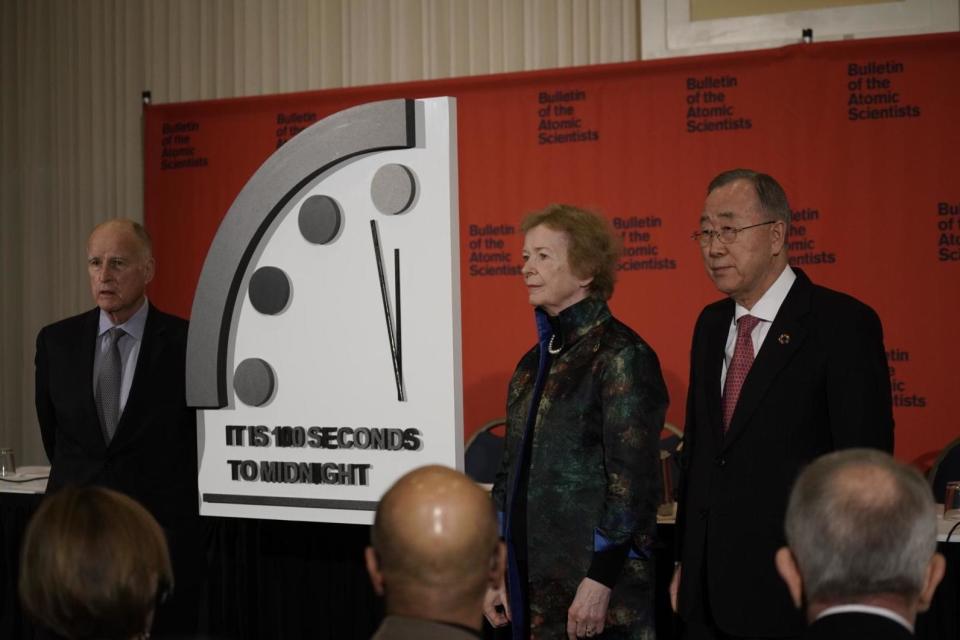What is the Doomsday Clock? As the BAS announces '100 seconds til the end of the world', this is what it means

If the thought of the Doomsday Clock striking 100 seconds to midnight is sinister, that is the aim.
Scientists have moved the dial’s minute hand a step closer to humanity’s day of reckoning.
It may seem too sci-fi like to be true, but in fact this is real life - not from a film.
What is the Doomsday Clock?
The Bulletin of Atomic Scientists, a group of experts, created the clock in 1947 to provide a metaphor for the threats facing our planet.
The team review its ‘time’ every year, according to how endangered they judge the survival of Earth to be.
It was first set up by US scientists behind the Manhattan Project, a bomb-making programme during World War Two, to warn the wider population of the risks involved in nuclear war.

In a first for this year, the BAS Science and Security Board, a panel including 13 Nobel Laureates, were joined by The Elders, a network of global leaders set up by Nelson Mandela.
How does this compare to previous years?
Throughout the last 73 years, the clock has been measured by minutes, but this year it has ticking by seconds, and closer to apocalypse than ever before.
“It is now 100 seconds to midnight,” announced Rachel Bronson, the BAS president, at a press conference in Washington last night, the closest it has ever been to the hour.

In 2019 the time was set at two minutes to midnight, and even at the height of US-Russia tensions during the Cold War, in 1984, it was at three minutes.
The lowest point it hit was 17 minutes to 12, in 1991 shortly after the Berlin Wall fell, but it has been steadily increasing since 2015.
Why have they changed the time now?
BAS says we’re facing the worst ever cocktail of threats in a generation: climate change, nuclear proliferation and “cyber-based misinformation”.
It cites the collapse of the Iran nuclear weapons deal, an ongoing bomb testing programme in North Korea, and proliferation in Russia, the US and China. Last August the Intermediate-Range Nuclear Forces (INF) treaty between the former Cold War enemies, signed in 1987, collapsed.

Professor Sharon Squassoni, of Georgetown University, told reporters that the situation is “dangerous” and requires an “urgent response”.
“I have to admit that we already set the clock in November,” she added.
“This was before recent military actions by the US and Iran, Iran’s statement or threat that it might leave the Nuclear Non-Proliferation Treaty, and North Korea’s abandonment of talks with the United States”, hinting it might be even closer to self-destruction now.
What did the panel say about climate change?

Climate change also weighed in their decision, with last year’s global average surface temperature the second hottest ever.
BAS accused world leaders of making “polished speeches” at UN climate talks without providing meaningful solutions to issues such as the Australian bushfires crisis, fossil fuel usage and the rapid melting of glaciers.
But the committee issued a third warning as the US presidential election nears: "government-used cyber-enabled disinformation campaigns to sow distrust in institutions and among nations".
Board member Robert Latiff cautioned that "untruths, exaggerations and misinterpretations" could cause the "wholesale trashing" of scientific evidence, pointing to the rise of so-called deepfake videos and fake news.
Former Irish President Mary Robinson said she had become “an angry granny” at the current state of affairs, adding: "The world needs to wake up."
Jerry Brown, ex California governor and another member of the panel, illustrated how the threats are linked.
"Dangerous rivalry and hostility among the superpowers increases the likelihood of nuclear blunder,” he said. “Climate change just compounds the crisis. If there's ever a time to wake up, it's now."

 Yahoo News
Yahoo News 